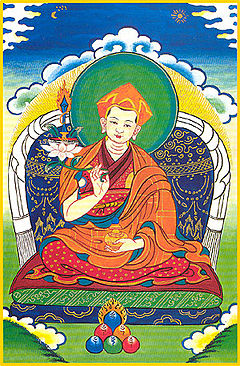Pema Rigdzin, 1st Dzogchen Rinpoche
[2] In the iconographic representation of Pema Rigdzin herewith, within his right or upaya-hand he holds the stem of a lotus (Sanskrit: padma (attribute) sprouting from his heartmind chakra (Tibetan: འཁོར་ལོ་, Wylie: 'khor lo) that functions as a dais for the Dharma, represented by a book or tomb, which in turn supports the flaming sword of prajna (Sanskrit) often seen as an attribute of Manjushri.
Iconographically, flames denote 'spiritual power' in the Himalayan thangka twilight language tradition.
The triratna is represented by the stylized trefoil pattern upon the foundation of the throne that supports him.
In his left or prajna-hand at the level of the Muladhara (or one of the other three foundation ′khor lo) is the 'Urn of Wisdom' (Sanskrit: bumpa) which is one of the Ashtamangala.
The foundation of wisdom is an awareness of the 'base' (Tibetan: གཞི་, Wylie: gzhi), a very important theological concept and locus of practice in traditions of Dzogchen.
